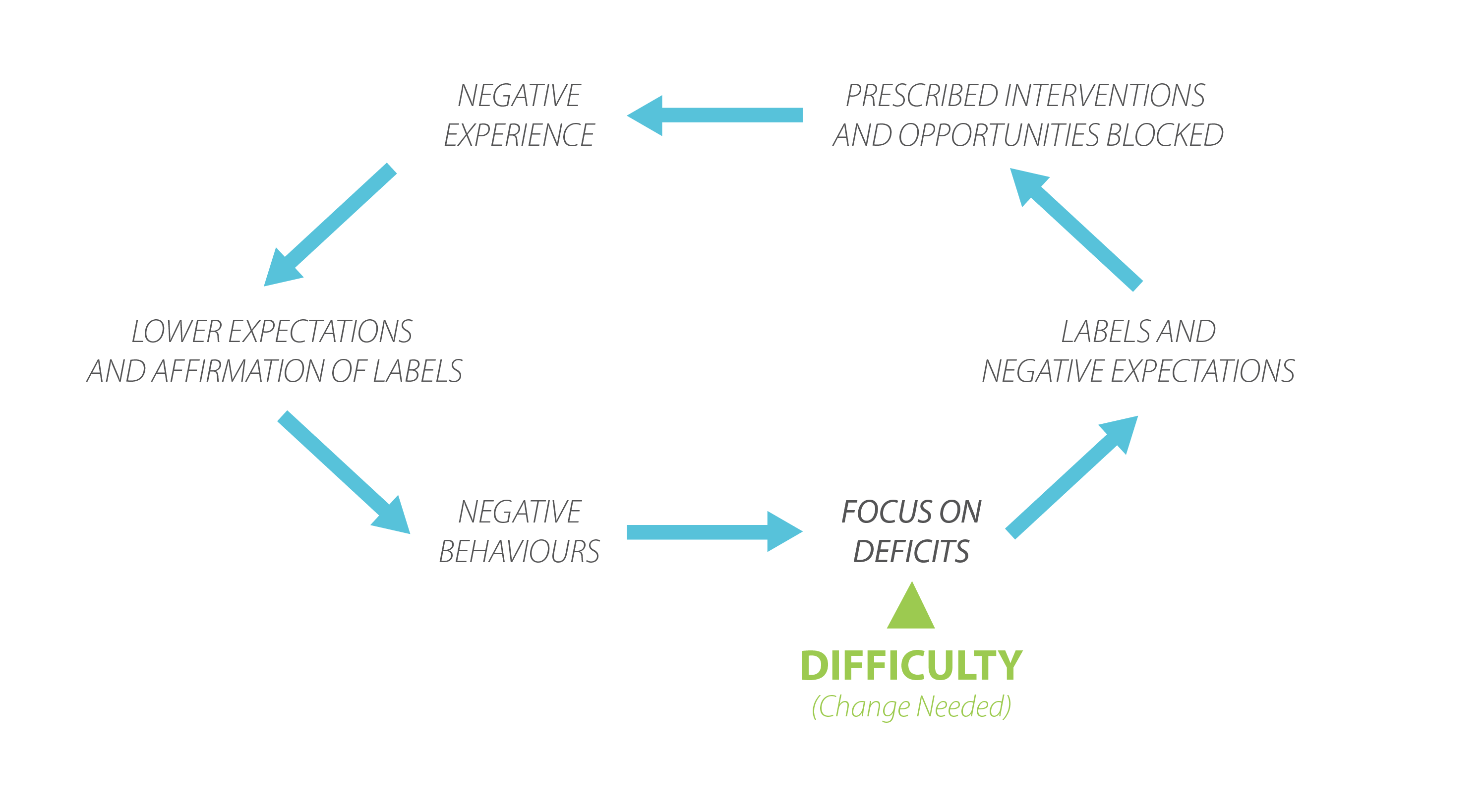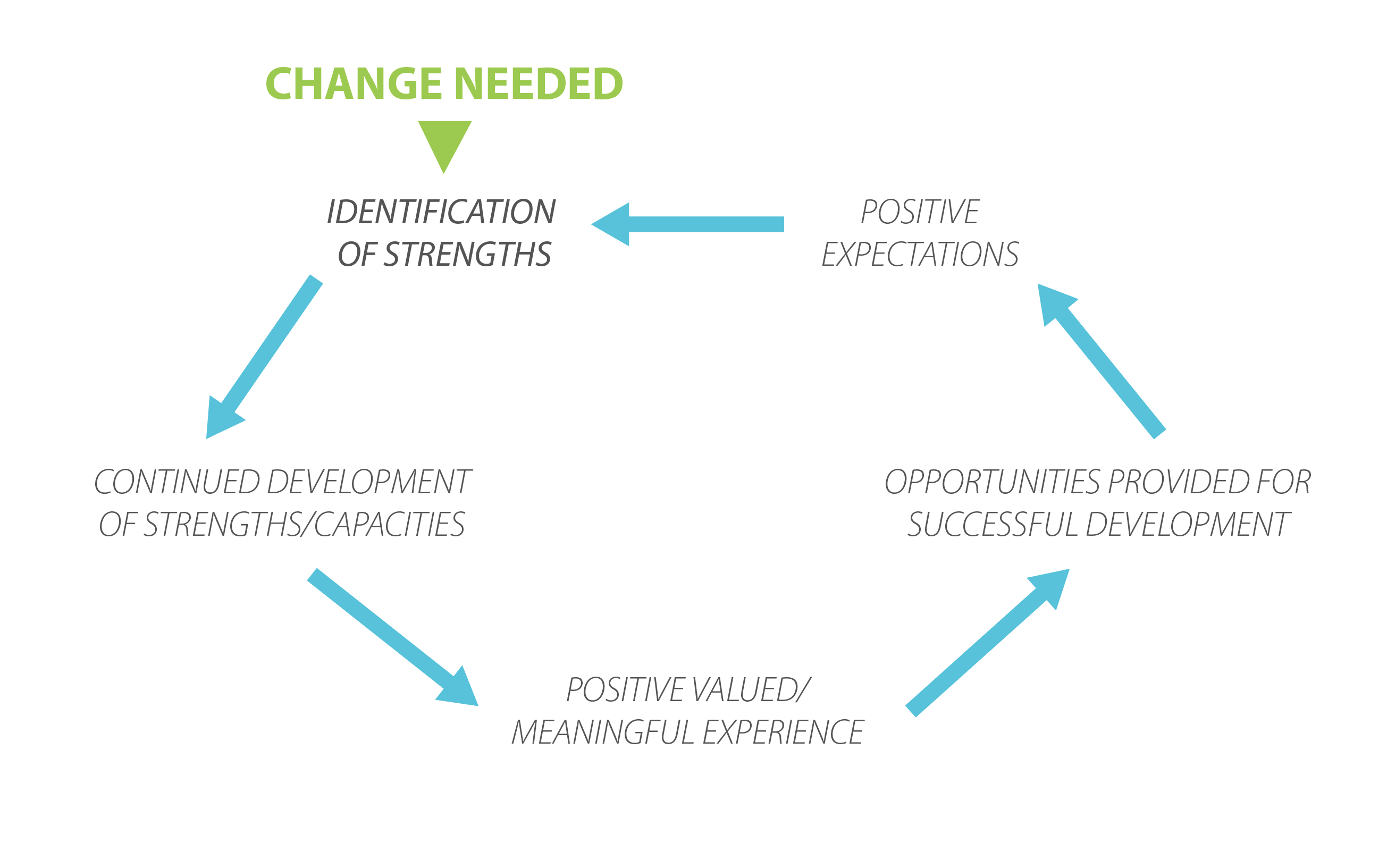Youth-serving social agencies, and indeed, many social service organizations often look at clients as “people with problems”. Staff ask “what’s wrong with this person?” or “How can I fix this person?” The point of origin in service-delivery is therefore based in weakness and creates an imbalance of power between the service provider and the client. Expectations for success are lowered and the client is disempowered.
Hammond and Zimmerman say that “McCaskey (2008) outlines a deficit cycle (see below) to explain the perspective that if we understand a problem, all we need to do is find an expert to analyze it then find a prescription that will fix it. This focus starts with a ‘needs assessment’ as it is believed that if it can be determined as to what is wrong and work out what the needs are we will know what needs to be done. However, this often leads to simplistic and narrow solutions that rarely address the real issues in the long term”.
The Deficit Cycle

A strength-based approach on the other hand, says “What’s right with this person?” It looks at each individual as someone with power and the ability to change their own circumstances. It recognizes that every person has strengths and abilities and looks to see how those skills can be enhanced.
Strength-based approaches emphasize the saying “the person is not the problem, the problem is the problem”.
The Strengths-Based Cycle

“The strengths-based cycle ... begins with a more holistic focus that includes an emphasis on a person’s strengths and resources (internal and external) in the process of change. When challenges are experienced, problems and issues are acknowledged and validated, and strengths are identified and highlighted. This strengths exploration changes the story of the problem as it creates positive expectations that things can be different and opens the way for the development of competencies”.
The principles of strength-based practice are:
- “An absolute belief that every person has potential and it is their unique strengths and capabilities that will determine their evolving story as a well as define who they are – not their limitations (not, I will believe when I see – rather, I believe and I will see).
- What we focus on becomes one’s reality – focus on strength, not labels – seeing challenges as capacity fostering (not something to avoid) creates hope and optimism.
- The language we use creates our reality – both for the care providers and the children, youth and their families.
- Belief that change is inevitable – all individuals have the urge to succeed, to explore the world around them and to make themselves useful to others and their communities.
- Positive change occurs in the context of authentic relationships – people need to know someone cares and will be there unconditionally for them. It is a transactional and facilitating process of supporting change and capacity building – not fixing.
- Person’s perspective of reality is primary (their story) – therefore, need to value and start the change process with what is important to the person – not the expert.
- People have more confidence and comfort to journey to the future (the unknown) when they are invited to start with what they already know.
- Capacity building is a process and a goal – a life long journey that is dynamic as opposed to static.
- It is important to value differences and the essential need to collaborate – effective change is a collaborative, inclusive and participatory process – ‘it takes a village to raise a child’”.
Train for Trades staff recognize the unique capacity of each youth and focus on their strengths rather than weaknesses. While they support youth through challenges, they also show youth what they are capable of. Many of the youth and staff talked about how great it felt to be giving back to the community and to help tenants reduce energy costs.
“Spend a day in a basement and see how well people picked off the street basically –people who weren’t prior really going anywhere—how well they do what they do in those basements. I came in, I had no training, no experience doing what I’m doing. And within days I was getting things done like a professional!” — Matthew, age 21, Tier 1 participant, Train for Trades
Homeless Hub Thoughts:
Some youth-service agencies choose to base their work in a number of theoretical underpinnings or to use specific theoretical approaches in dealing with youth support. Train for Trades does this to a certain extent with their focus on strength-based and harm reduction approaches, although these are less “theory” and more “ways of doing the work”. That said, it is likely that the Youth Support Workers and the Youth Supports Coordinators utilize a number of theories in their day-to-day work unknowingly. Often, academics develop theories that those involved in the trenches just consider to be part of everyday work.
The harm reduction and strength-based approaches are very integral to the work that Train for Trades does. They are a very pragmatic and youth-based way of doing the work and this is likely an important part of T4T’s success.
For a more extensive look at how theory can be embedded in the work, approaches to youth, case management and evaluation look at the Theories to Support the Work section of the Youth Transitional Housing Toolkit. Covenant House Vancouver and Toronto use a number of theories in their interactions with youth in their programs.

